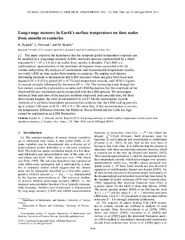Long-range memory in Earth's surface temperature on time scales from months to centuries
Permanent lenke
https://hdl.handle.net/10037/5992Dato
2013Type
Journal articleTidsskriftartikkel
Peer reviewed
Sammendrag
The paper explores the hypothesis that the temporal global temperature response can be modeled as a long-range memory (LRM) stochastic process characterized by a Hurst exponent 0.5 < H≲1.0 on time scales from months to decades. The LRM is a mathematical representation of the multitude of response times associated with the various subsystems. By analysis of instrumental and reconstructed temperature records, we verify LRM on time scales from months to centuries. We employ well-known detrending methods to demonstrate that LRM increases when one goes from local and regional (H≈0.65) to global (H≈0.75) land temperature records, and LRM is highest in records strongly influenced by the ocean (H≈1.0). The increasing trend through the last century cannot be explained as an unforced LRM fluctuation, but the amplitude of the observed 60 year oscillation can be reconciled with the LRM process. We investigate statistical bias and error of the analysis methods employed, and conclude that, for these short record lengths, the error in estimated H is ±0.07 for the instrumental records. Analysis of a northern-hemisphere reconstruction confirms that the LRM-scaling prevails up to at least 250 years with H=0.9±0.1. We show that, if this reconstruction is correct, the temperature difference between the Medieval Warm Period and the Little Ice Age cannot be explained as an LRM fluctuation.
Beskrivelse
This paper is part of Lene Østvand's doctoral thesis which is available in Munin at http://hdl.handle.net/10037/6391
Forlag
American Geophysical Union (AGU)Sitering
Journal of Geophysical Research: Atmospheres 118(2013) nr. 13 s. 7046-7062Metadata
Vis full innførselSamlinger
Følgende lisensfil er knyttet til denne innførselen:


 English
English norsk
norsk